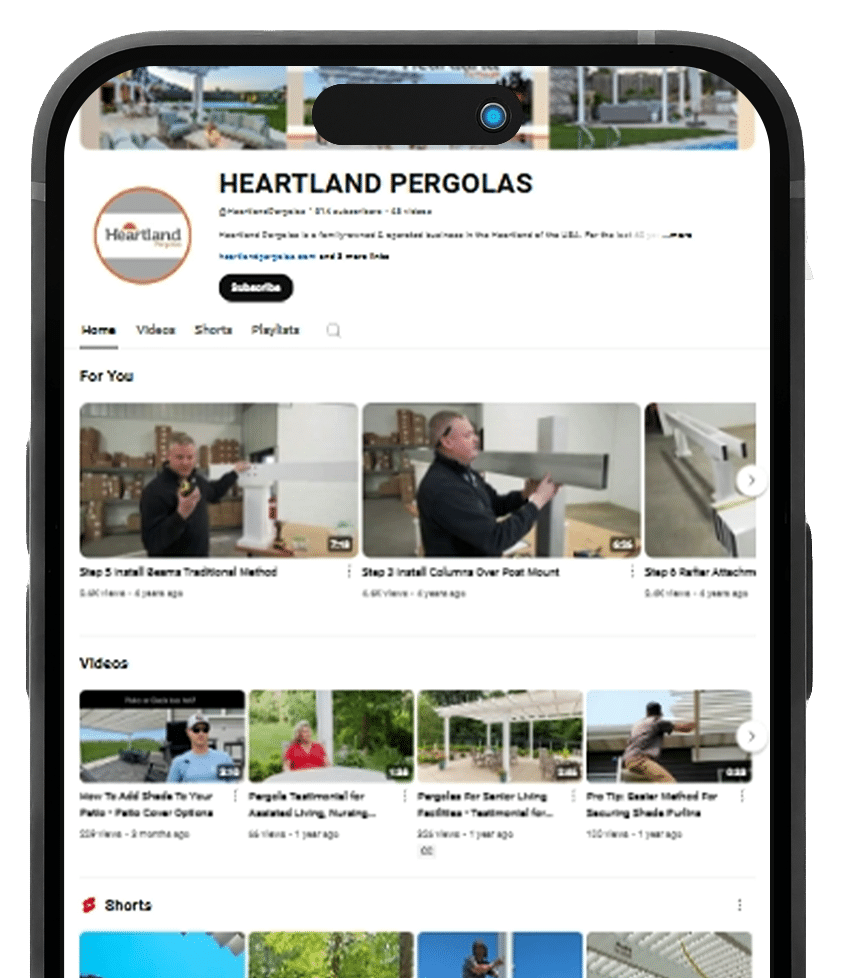Pergolas With Roofs: Why Heartland Pergolas Do Not Need Roofs
Outdoor living spaces have dramatically increased in popularity over the last year, and with outdoor living spaces comes the need for things like shade and definition of the various areas. There are many structures that can be used for these types of things, and pergolas are one of the most used and loved.
The traditional pergola does not have a formal roof — only rafters and beams that can be used to support vines or cloth for shade — however, there are many new variations on the market. Some offer the ability to increase or decrease light and shade without fully encasing the space. Others have solid roofs over them, which changes the pergola into something else entirely — a pavilion.
While pavilions have their uses, they lack many of the benefits of a pergola, particularly when people try to have the best of both worlds by creating a pergola/pavilion hybrid that features glass or polycarbonate roofs that let light in.
Benefits of a Pergola
Pergolas provide shade, much like pavilions and gazebos, but they do it differently. They also allow in light and air, which gives them a more open feeling than an enclosed gazebo or a fully roofed pavilion. It also makes them less expensive, since most of the costs of building a gazebo or pavilion go into the roof.
Traditional pergolas allow the user to customize the amount of shade and sunlight they want. By using things like sailcloth or vines, you could increase the amount of shade, without increasing costs or removing the feeling of light and air.
Heartland Pergolas takes this a step further. Their angled shade systems allow you to customize the amount of shade from 50% up to 90%. So, whether the area you are placing your pergola in needs just a little shade or a lot, you can still have the airy benefits of a pergola, without the cost of a full roof.
Downsides of a Full Roof
Adding a full roof to your structure in order to turn the pergola into a pavilion can create a lot of additional challenges.
First, many pergolas are positioned right next to the house. For a full roof in this location to look aesthetically pleasing, it would need to match it to your existing roofline. You would also have to find a way to deal with rain and standing water, as a flat roof would allow water to collect, causing damage and leaks over time. Therefore, your pergola structure would need to be further away from your home, with a hipped or capped roof and with enough of a pitch to allow rainwater to run off naturally.
While this will provide you with shade, it becomes more of an open-sided house, rather than a defining garden structure. The weight of the roof will mean that the columns will need to be larger and heavier to support it, along with a strong foundation as well.
The end result is a simple project meant to add some definition and shade to your patio becomes a much larger and more expensive project than you may have had in mind.
Downsides to Polycarbonate Roofs
Many people try to roof their pergola with a polycarbonate top. They feel that this provides some of the sunlight, while also blocking UV rays. It also helps to keep the rain out, making the area beneath usable, even on less than sunny days.
However, these tops have drawbacks besides the weight and added expense to the structure. They can block some UV rays, but they can increase the temperature of the area beneath the roof. Instead of giving you shade and a cooler place to relax, they’re actually hotter than if there was no structure there at all.
They can also be difficult to keep clean, as any type of debris will sit on top. Plus, things like dirt and pollen can leave stains that create a yellow film, detracting from its appearance. And cleaning is difficult, involving a ladder and water, which can be a dangerous combination.
If you are looking to pull a permit for your pergola installation it will be very tough to get your polycarbonate roof panels to pass code. Wind and snow ratings vary throughout the country and the addition of a polycarbonate roof may require you to purchase an individualized engineer test for your specific unit to pass code. This can be costly and time consuming.
The Freedom of Pergolas
A pergola kit from Heartland can give you a lot more options than a roofed pavilion can. It’s lighter and therefore less expensive. They can be built and assembled in less time and in more places and they’re much more adaptable to unique sizes and shapes. And with their shade options, you can get the overhead coverage you need for even the sunniest spaces, without the hassles of a solid roof.
Choose a Classic Pergola, Not a Pavilion
If you’re looking to add some definition, structure and shade to your property, choose a real pergola — not a pavilion. Don’t fall for the idea that a full roof may improve your experience; only true pergolas offer you the right amount of sunlight and shade at the right price for every budget.
Contact the pergola design experts at Heartland Pergolas today to learn more about the best pergola for your home.


